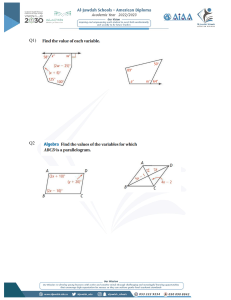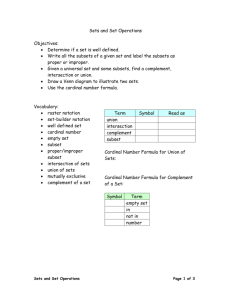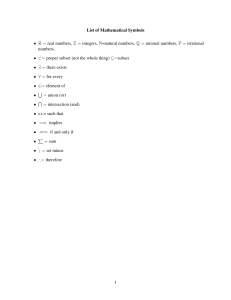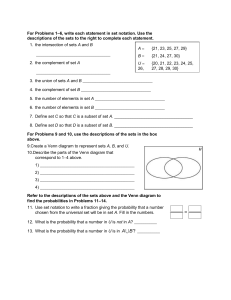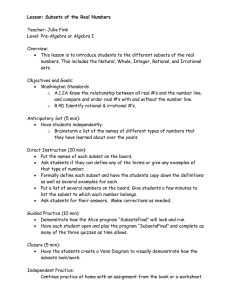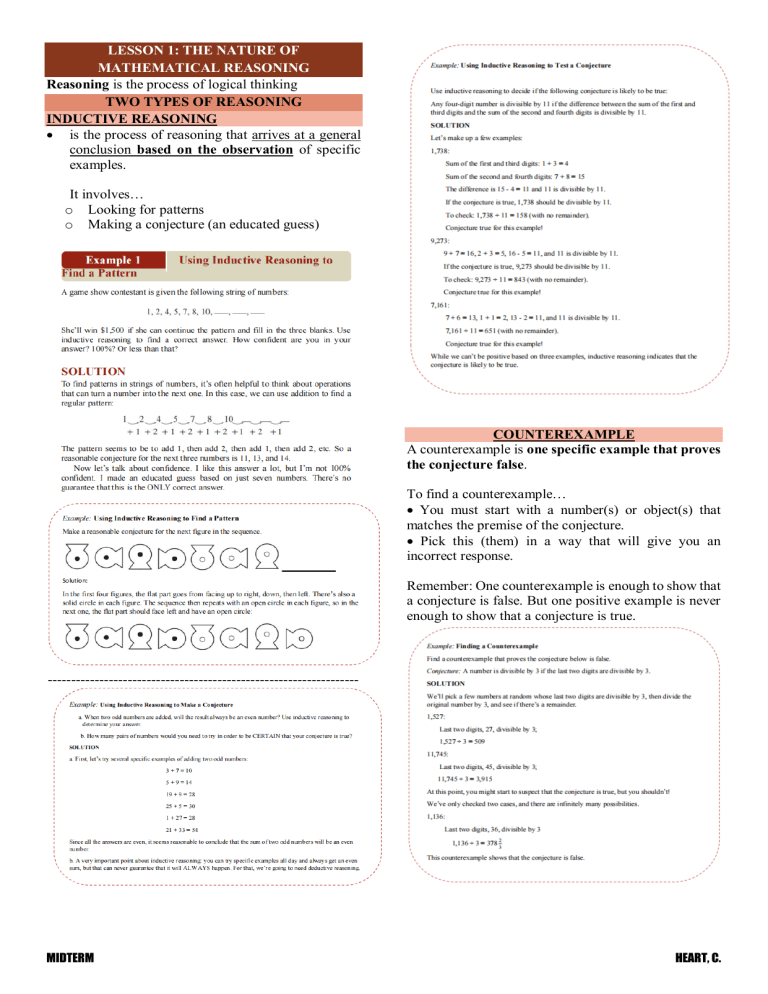
LESSON 1: THE NATURE OF
MATHEMATICAL REASONING
Reasoning is the process of logical thinking
TWO TYPES OF REASONING
INDUCTIVE REASONING
is the process of reasoning that arrives at a general
conclusion based on the observation of specific
examples.
It involves…
o Looking for patterns
o Making a conjecture (an educated guess)
COUNTEREXAMPLE
A counterexample is one specific example that proves
the conjecture false.
To find a counterexample…
You must start with a number(s) or object(s) that
matches the premise of the conjecture.
Pick this (them) in a way that will give you an
incorrect response.
Remember: One counterexample is enough to show that
a conjecture is false. But one positive example is never
enough to show that a conjecture is true.
------------------------------------------------------------------
MIDTERM
HEART, C.
DEDUCTIVE REASONING
Deductive reasoning is the process of reasoning that
arrives at a conclusion based on previously
accepted general statements.
It’s based on overall rules, NOT specific examples.
----------------------------------------------------------------
----------------------------------------------------------------
----------------------------------------------------------------
MIDTERM
HEART, C.
LESSON 2: POLYA’S 4 STEP PROBLEM
Polya’s Four-Step Problem-Solving Procedure
Step 1: Understand the problem.
Read the problem slowly, jotting down the key ideas
Step 2: Devise a plan to solve the problem.
Draw a diagram, find a formula, look for patterns
Step 3: Carry out the plan to solve the problem.
Solve the problem, follow the numbers, and create an
equation
Step 4: Check your answer.
Does your answer make sense?
Did you solve for the requested unknown?
------------------------------------------------------------------
MIDTERM
HEART, C.
------------------------------------------------------------------------
MIDTERM
HEART, C.
LESSON 3 : INTRO TO SET THEORY
SETS
A set is a collection of objects.
A set is well-defined if for any given object, we
can objectively decide whether it is or is not in
the set.
Each object in a set is called an element or a
member of the set.
DESCRIPTIVE METHOD
uses a short verbal statement to describe the
set.
Ex. Use the descriptive method to describe the set B
containing 2, 4, 6, 8, 10, and 12 in two different ways.
ANS. B is a set of even natural numbers less than 14.
ROSTER METHOD
One method of designating a set is called the
roster method, in which elements are listed
between braces, with commas between the
elements.
Often, we’ll name sets by using a capital letter.
SET-BUILDER NOTATION
The third (and fanciest) method of designating a set
and this method uses variables.
A variable is a symbol (usually a letter) that can
represent different elements of a set.
Set-builder notation uses a variable, braces, and a
vertical bar | that is read as “such that.”
For example, the set {1, 2, 3, 4, 5, 6} can be
written in set-builder notation as
This is read as “the set of elements x such that x is a
natural number and x is less than 7.”
EMPTY OR NULL SET
NATURAL NUMBERS, ∈, ∉
In math, the set of counting numbers or
natural numbers is defined as N = {1, 2, 3,
4, . . .}No decimal/fraction or negative numbers.
(When we are designating sets, the three dots,
or ellipsis, mean that the list of elements
continues indefinitely in the same pattern.)
The set E = {2, 4, 6, 8, . . .} is the set of even
natural numbers and the set O = {1, 3, 5, 7, . . .}
is the set of odd natural numbers.
The symbol ∈ is used to show that an object is
a member or element of a set.
The symbol ∉ shows when an object is not a
member of a set.
MIDTERM
A set with no elements.
The symbols used to represent the empty set are
{ } or Ø.
CARDINAL NUMBER OF A SET
the number of elements in the set.
For a set A the symbol for the cardinality is n(A),
which is read as “n of A.”
EX. For example, the set R = {2, 4, 6, 8, 10} has a
cardinal number of 5 since it has 5
elements.
FINITE OR INFINITE
Finite is a set with no elements, or has cardinality
that is a natural number.
Infinite is a set that is not finite.
{10, 20, 30, . . .} is an infinite set since it has an
unlimited number of elements: the natural numbers
that are multiples of 10.
HEART, C.
EQUAL AND EQUIVALENT SETS
Two sets are equal if they have exactly the same
members or elements.
Two finite sets are said to be equivalent if they have
the same number of elements.
NOTE: All equal sets are equivalent since both sets
will have the same number of members, but not all
equivalent sets are equal.
SUBSETS AND SET OPERATIONS
UNIVERSAL SET
for a given situation, symbolized by U, is the set of
all objects that are reasonable to consider in that
situation.
The universal set from which elements of A can be
chosen is U = {1, 2, 3, 4, 5, 6, 7, 8}. The set A is {2,
4, 6, 8}, and the elements not in A are {1, 3, 5, 7}.
We will call the elements in U that are not in A the
complement of A, and denote it A′.
COMPLEMENT
ONE -TO-ONE CORRESPONDENCE
two sets have a one-to-one correspondence of
elements if each element in the first set can be
paired with exactly one element of the second set
and each element of the second set can be paired
with exactly one element of the first set.
The complement of a set A, symbolized A′, is the
set of elements in the universal set that are not in A.
Using set-builder notation, the complement of A is
A′= {x | x ∈ U and x ∉ A}
VENN DIAGRAM FOR COMPLEMENT
In a Venn diagram, the complement of a set A is all
the things inside the rectangle that are not inside the
circle representing set A.
CORRESPONDENCE AND EQUIVALENTS
SETS
Two sets are
Equivalent if you can put their elements in one-toone correspondence.
Not equivalent if you cannot put their elements in
one-to-one correspondence.
MIDTERM
HEART, C.
SUBSETS
If every element of a set A is also an element of a
set B, then A is called a subset of B.
The symbol ⊆ is used to designate a subset; in this
case we write A⊆ B.
Figure 2-5 A ∩ B = {14, 15}
Every set is a subset of itself. Every element of a set
A is of course an element of set A, so A ⊆ A.
PROPER and IMPROPER SUBSET
If a set A is a subset of a set B and is not equal to
B, then we call A a proper subset of B, and write
A ⊂ B.
U = {1, 2, 3, 4, 5}, A = {1, 3, 5}, and B = {1, 3}.
Improper subset; That is, A ⊆ B and A ≠ B.
The symbol ⊄ is used to indicate that the set is not
a proper subset.
Improper subset= tanan/equal
Proper subset= Set B is in Set A but is not equal
The Number of Subsets for a Finite Set
If a finite set has n elements, then the set has 2n
subsets and 2n − 1 proper subsets.
Ex.
a) Find the number of subsets and proper subsets of the
set {Ace, King, Queen, Jack, Ten, Nine}
DISJOINT
When the intersection of two sets is the empty set,
the sets are said to be disjoint.
The Venn diagram for a pair of disjoint sets A and
B is shown in Figure 2-6. If the sets have no
elements in common, the circles representing them
don’t overlap at all.
UNION
Another way of combining sets to form a new set
is called union.
The union of two sets A and B, symbolized by A
∪ B, is the set of all elements that are in either set
A or set B (or both). In set-builder notation,
Note that the word “or” means union.
For example, if A = {5, 10, 15, 20} and B = {5, 20,
30, 45}, then the union A ∪ B = {5, 10, 15, 20,
30, 45}. Even though 5 and 20 are in both sets, we
list them only once in the union.
SOL:
The set has n = 6 elements, so there are 2n, or 26 = 64,
subsets. Of these, 2n –1, or 63, are proper.
INTERSECTION AND UNION OF SETS
INTERSECTION
The intersection of two sets A and B, symbolized
Figure 2-7 A ∪ B
by A ∩ B, is the set of all elements that are in
both sets.
In set-builder notation, A ∩ B = {x | x ∈ A and ∈
B}.
Note that the word “and” means intersection.
For example, if A = {10, 12, 14, 15} and B = {13,
SET SUBTRACTIONS
The difference of set A and set B is the set of
elements in set A that are not in set B.
In set-builder notation,
A − B = {x | x ∈ A and x ∉ B}
14, 15, 16, 17}, then the intersection A ∩ B = {14,
15}, since 14 and 15 are the only elements that are
common to both sets.
MIDTERM
HEART, C.
LESSON 4 : USING VENN DIAGRAMS TO
STUDY SET OPERATIONS
VENN DIAGRAM WITH THREE SETS
Region I represents the elements in set A but not in set
B or set C.
Region II represents the elements in set A and set B but
not in set C.
Region III represents the elements in set B but not in set
A or set C.
Region IV represents the elements in sets A and C but
not in set B.
Region V represents the elements in sets A, B, and C.
Region VI represents the elements in sets B and C but
not in set A.
Region VII represents the elements in set C but not in
set A or set B.
Region VIII represents the elements in the universal set
U, but not in set A, B, or C.
MIDTERM
DE MORGAN’S LAW
For any two sets A and B,
(A B) = A B
(A B) = A B
The first law states that the complement of the union
of two sets will always be equal to the intersection
of the complements of each set.
The second law states that the complement of the
intersection of two sets will equal the union of the
complements of the sets.
HEART, C.
-------------------------------------------------------------
MIDTERM
HEART, C.
LESSON 5 : APPLICATIONS OF LINEAR
EQUATIONS
General Procedure for Solving Word Problems
Using Equations
Step 1: Read the problem carefully.
Draw a diagram, jot down the key ideas.
Step 2: Assign a variable to an unknown quantity.
Most of the time, the variable should represent the
quantity you’re being asked to find.
Step 3: Write an equation.
Keep an eye out for statements in the problem indicating
two different ways to express the same quantity
Step 4: Solve the equation.
Step 5: Make sure that you answer the question!
Step 6: Check to see if your solution makes sense.
Common Phrases That Represent Operations
Phrases that represent addition
6 more than a number
6+x
A number increased by 8
x+8
5 added to a number
5+x
The sum of a number and 17
x + 17
Phrases that represent subtraction
18 decreased by a number
18 − x
6.5 less than a number
x − 6.5
3 subtracted from a number
x−3
The difference between a number and 5
x–5
Phrases that represent multiplication
8 times a number
8x
Twice a number
2x
A number multiplied by 4
4x
The product of a number and 19
19x
of a number
x
Phrases that represent division
A number divided by 5
x÷5
35 divided by a number
35 ÷ x
The quotient of a number and 6
x÷6
MIDTERM
HEART, C.
MIDTERM
HEART, C.

